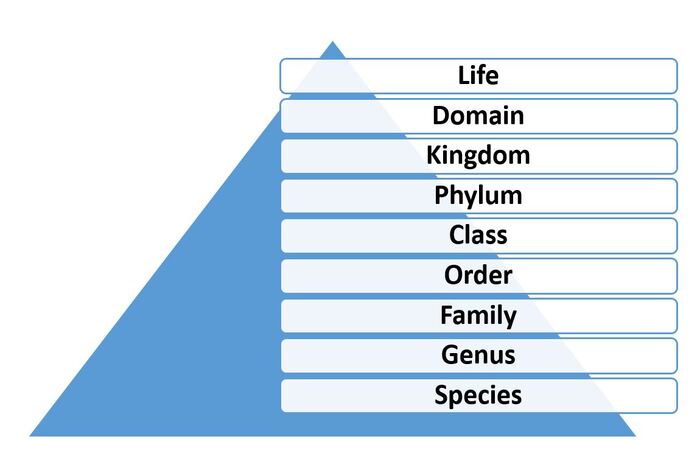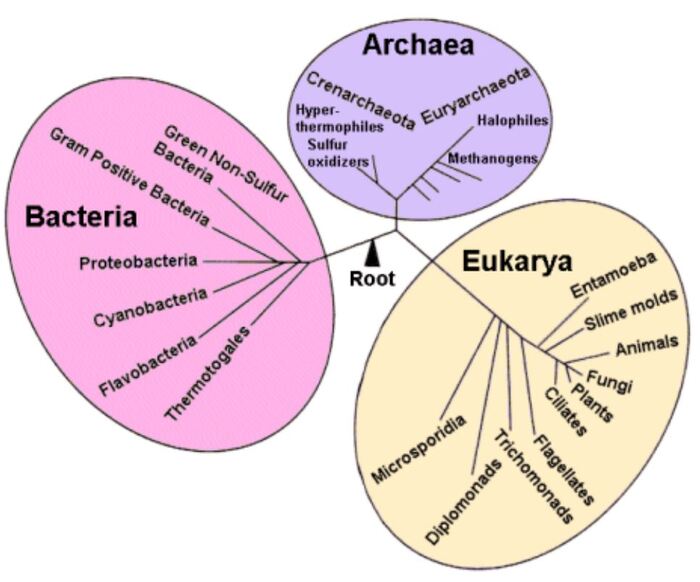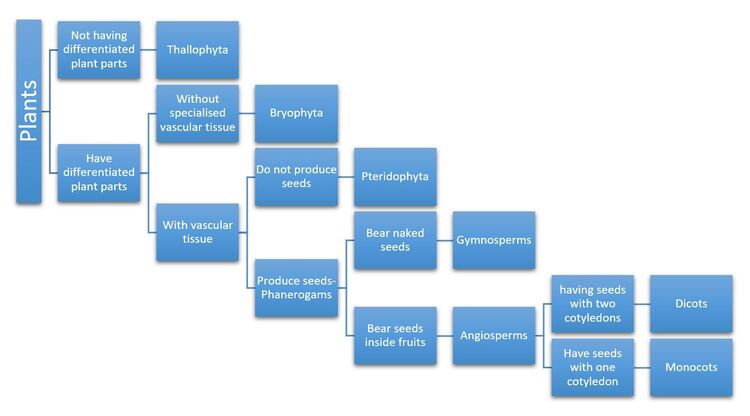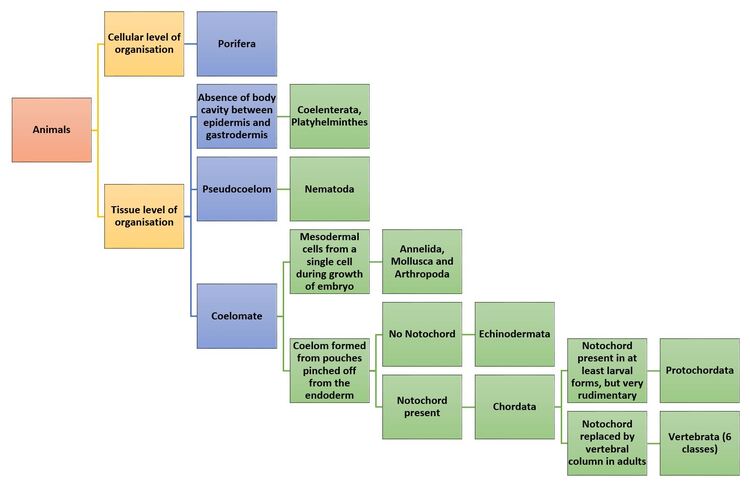Five Kingdom Classification of organisms and Domains of Classification
Grouping of Organisms based on similarities and differences is called classification. A hierarchy is maintained when an organism is classified into various categories. Similarly, an organism belongs to Kingdom, Phylum, Class, Order, Family, Genus and Species in hierarchical order. The classification (also called Systematics) shows evolutionary relationships between organisms.

Fig.1: Hierarchy of Classification
1. Introduction
Aristotle was the earliest one who tried a scientific basis for classification. Linnaeus (known as Father of Taxonomy) placed all organisms into Plantae and Animalia in the book “Systema Naturae”. Taxonomy is the science of classification. Classification is closely related to evolution. Charles Darwin first described evolution in 1859 in his book. The book was titled as The Origin of Species. Species is the basic unit of classification.
Robert Whittaker gave five kingdom classification of organisms. Monera, Protista, Fungi, Plantae and Animalia are five kingdoms proposed by Whittaker. Carl Woese divided Monera into Archaebacteria (or Archaea) and Eubacteria (or Bacteria).
2. Three Domains of Classification
Organisms are now categorised into three major domains. These domains are as follows:
- Archaebacteria: Thermophilic or heat-loving bacteria living in high-temperature vents.
- Eubacteria: Single-celled organisms without a well-developed nucleus.
- Eukarya: All other organisms with a well-developed nucleus in their cell/cells.

Fig. 2: Three domains of classification (Source: NIOS)
3. Whittaker’s five kingdom classification
In Whittaker’s five kingdom classification, unicellular (single-celled) prokaryotes are placed in the Kingdom Monera and unicellular eukaryotes are placed under the Kingdom Protista. Multicellular eukaryotes with a cell wall are placed in Kingdom Fungi if they do not perform photosynthesis.
Multicellular eukaryotes with a cell wall are placed in Kingdom Plantae if they perform photosynthesis. This classification places multicellular eukaryotes without a cell wall into Kingdom Animalia.

Fig.3: The Five Kingdom Classification
3.1 Kingdom Monera
They lack defined nucleus or organelles and multi-cellular body designs. Cell wall is found in some of them. The organisms in this group show autotrophic or heterotrophic mode of nutrition. Bacteria, blue-green algae or cyanobacteria and mycoplasma are included in this group of organisms. Bacteria are the most abundant micro-organisms. Monera has been divided into Archaebacteria and Eubacteria.
3.2 Kingdom Protista
Different kinds of unicellular eukaryotic organisms come under this group. The boundaries of this kingdom are not well defined. Some of the organisms placed in this group use appendages, for example, hair-like cilia or whip-like flagella for locomotion. The mode of nutrition can be autotrophic or heterotrophic. Unicellular algae, diatoms and protozoans are included in this group.
Note:
In autotrophic mode of nutrition, organisms synthesise their own food.
In heterotrophic mode of nutrition, organisms get food from the environment.
This kingdom is categorized into Chrysophytes, Dinoflagellates, Euglenoids, Slime moulds, and Protozoans.
3.3 Kingdom Fungi
This kingdom includes heterotrophic eukaryotic organisms. Some of the organisms in this group are saprotrophs. Some are parasites. Some of them live in symbiotic relationships with cyanobacteria. The cell wall of organisms in this group is made up of Chitin. Yeasts, molds and mushrooms are examples of organisms included in this group.
Note:
Saprotrophs are organisms that use decaying organic substances as food.
Parasites require protoplasm of a host organism for food.
Lichens are organisms formed as a result of symbiotic association between fungi and cyanobacteria.
The kingdom is classified into Phycomycetes, Ascomycetes, Basidiomycetes, and Deuteromycetes.
3.4 Kingdom Plantae
Organisms in this group are multicellular eukaryotes having cell walls. They do photosynthesis by using chlorophyll. They are autotrophs.
Thallophyta includes plants that do not have differentiated parts. Plants without specialised vascular tissue are placed in Bryophyta. Plants that have vascular tissue but do not produce seeds are placed in Pteridophyta. Plants that have vascular tissue and produce naked seeds come under Gymnosperms.
Plants that have vascular tissue and produce seeds inside fruits are called Angiosperms. Angiosperms having seeds with two cotyledons are called dicots. Angiosperms having seeds with one cotyledon are called monocots. The term phanerogams refers to all plants which produce seeds.

Fig.4: Classification of Plants
3.5. Kingdom Animalia
The organisms in this group are multicellular eukaryotes without cell walls. They are heterotrophs.
Animals with the cellular level of organization are included in Porifera. Coelenterata and Platyhelminthes include animals with tissue level of organization and without body cavity between epidermis and gastrodermis. Animals with tissue level of organization and pseudocoelom are placed in Nematoda.
Animals included in Annelida, Mollusca and Arthropoda have mesodermal cells developed from a single cell at the time of growth of the embryo. Echinodermata includes coelomate animals with no notochord.
Chordata includes coelomate animals with notochord. Chordata is further divided into protochordata and Vertebrata. In Vertebrata, the notochord is replaced by vertebral column in adults. Vertebrata is divided into six classes.
(i) Cyclostomata: Jawless animals with circular mouths and scaleless slimy skin.
(ii) Pisces: Animals breathing through gills and having exoskeleton of scales and endoskeleton of bone/cartilage.
(iii) Amphibia: Animals with slimy skin, gills found in larva and lungs in most adults.
(iv) Reptilia: Animals with exoskeleton made up of scales.
(v) Aves: Animals with exoskeleton made up of feathers.
(vi) Mammalia: Exoskeleton of hairs, external ears present, mostly give birth to live young.

Fig.5: Classification of Animals
Summary
Taxonomy: Science of classification
Aristotle: Earliest one to attempt scientific basis for classification
Linnaeus: Father of Taxonomy, his book “Systema Naturae”,
Charles Darwin: First described evolution, his book The Origin of Species
Robert Whittaker: Gave five kingdom classification of organisms
Kingdom Monera: Lack defined nucleus, show autotrophic or heterotrophic nutrition, and include bacteria, cyanobacteria, and mycoplasma
Kingdom Protista: Unicellular eukaryotic, use appendages, include unicellular algae, diatoms and protozoans
Kingdom Fungi: Heterotrophic eukaryotic, saprotrophs, parasites, cell wall of Chitin, Yeasts, molds and mushrooms
Kingdom Plantae: Multicellular eukaryotes having cell walls, do photosynthesis, autotrophs, include Thallophyta, Bryophyta, Pteridophyta, Gymnosperms, and Angiosperms
Kingdom Animalia: Multicellular eukaryotes without cell walls, heterotrophs, include Porifera, Coelenterata and Platyhelminthes, Nematoda, Annelida, Mollusca and Arthropoda, Chordata, Vertebrata (six classes)






 Latest
Latest 



Comments